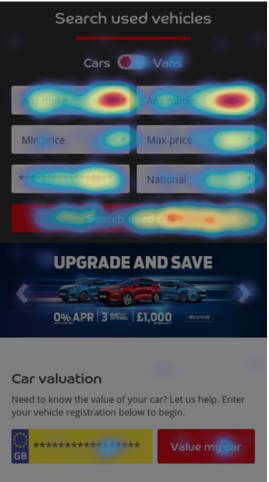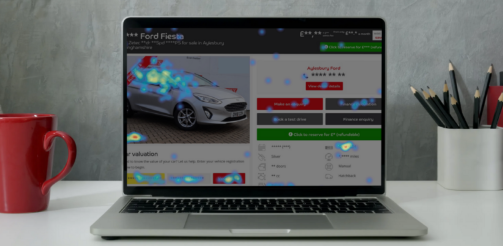Water the seeds and grow the leads
How customers engage with you and how you engage with your customers are two of the most important factors in building a successful car dealership, but I’m sure we don’t need to tell you that. What we can tell you is that there are ways to improve the quantity and quality of these leads. There are several free tools and approaches you can take in order to increase digital leads and ultimately turn these leads into customers.
See what users do when they hit your site - Heatmapping
What is heatmapping?
A website heatmap is a visual representation of your website visitors’ behaviour. It can help you assess the design of your webpages, spot any hurdles, and see exactly how your customer interact with your website. Heatmaps are often used by UX designers to see whether the navigation works well and perform CRO (Conversion Rate Optimisation) activities on certain pages.
Heatmaps will clearly highlight the areas of your website that are working well, and areas that need improvement from the horse’s mouth itself. Real data in real time, that is only relevant and accurate for your individual website.
How can heatmapping benefit me?
If website visitors are not interacting with certain element on a webpage as you hoped, there may be a reason as to why – this is how you can make a visual check. Because heatmapping shows exactly where your website visitors are clicking, how far they are scrolling on your pages and the movement of their mouse, you may be able to draw some conclusions when combining this information with analytical data.
If customers are not clicking where you want them to, perhaps it’s because there are too many other call-to-actions on the same page – are customers choosing to click those over the CTA you want them to? Maybe there is simply too much information which could be distracting to visitors and not give them a reason to move further through the website or enquire. Or is it because the specific call to action is too low on the page, that only 50% of visitors are actually reaching it? Heatmapping will provide an insight to this.
Heatmaps also provide a visual snapshot of ‘scroll depth’ percentages, i.e. how much of the page content is viewed by 100% of the audience, how much is viewed by 75%, viewed by only 50% and finally, what is seen by just 25% of the audience.
Space ‘Above the fold’ is limited, but armed with this heatmap information, you can make objective decisions regarding page layout, to ensure maximum visibility for your most important content.

How to do it...
There are many different online heatmapping tools, some of which are free and some that have more advanced features which are paid tools – we recommend using Hotjar, if you’re new to heatmapping as there is a free version too! The tool is easy to use and there’s plenty of guides to ensure you set up mapping correctly.
Let’s say using a heatmap identifies a certain call to action that isn’t being engaged with, instead of just making changes to the design or structure with no data to work from, make sure you know what isn’t working first! This leads nicely onto the next method – A/B Testing…

What is A/B testing?
A/B testing is an on-going tactic of conversion rate optimisation, used to improve website performance through user behaviour. It works by displaying two different variants of a webpage to your website visitors so you can see which performed best overall. With this data, you can then make objective ‘tweaks’ to your website.
Using the findings from the heatmap exercise, pinpoint what it is on your website that you would like to improve then you can create your test. For example, you might have discovered you are receiving a low volume of clicks on a certain call to action – by changing the wording on that specific call to action you can see, if any, what difference the change will make to the results, perhaps using ‘Free Car Valuation’ over ‘Value My Car’.
You can set the experiment so that 50% of your visitors will see ‘Free Car Valuation’ and the other 50% will see ‘Value My Car’. After the winning variant is confirmed, it does not end there. You can then choose to test something else; you could then compare the winner against another option. Or something completely different – for example, the colour of the text or a button. It depends on your individual case, what you are trying to find out and achieve.
How can A/B Testing benefit me?
A/B testing points out the best performing variant of a webpage each time, providing continuous improvements overtime. Doing it right can have huge advantages, with the main one being an increase in conversions.
It is important to only test one variant at a time to make sure your results are accurate. If the colour and the wording are both being tested at the same time, you will not be able to see whether it was the colour or the change of the wording that affected the engagement.
How to do it...
Google Optimize! It’s step by step, easy to follow and more importantly, it’s free, meaning you can get used to the tool, even with very little technical effort. All that is required to get started, is the placement of a piece of code onto your website.
Now that you have more leads, let’s discuss speed…
How quickly do leads need to be responded to?
Picture the scene, a customer is browsing a range of websites for used cars nearby and they have narrowed it down to two possible cars from different dealerships. They enquire at both; dealer A calls back automatically and books an appointment with the customer for the next morning. Dealer B doesn’t get back to the customer for 24 hours. The next day dealer A gets the sale…
The early bird catches the worm!
According to Leadsimple 64% of buyers go with the representative they speak to first, now this is in general terms and not specifically automotive. There is plenty of research on the ‘perfect lead response time’ so what is that sweet spot?
According to the same study – it’s between 5 and 30 minutes. Companies calling within this time window put themselves ahead of the race, but we understand it’s not realistic to set a target of calling every lead back in this short time frame.
Similarly, Dealerweb research has previously shown that almost 50% of buyers said that they were more likely to buy a car from the dealership who responds to an online enquiry within one hour. Also, 25% of those stated that they expected the dealer to respond in 30 minutes minimum. The next question is, how long is too long? Calling a lead within 5 hours is 40% more effective than calling after 24 hours. There is a clear link between fast enquiry response times and actual sales conversions. So, the moral of the story is to respond to leads as fast as humanly possible, aiming for under an hour.
For extremely fast responses 24/7 try live chat. Many automotive live chat providers give free trails or exclusive offers when partnered with website providers like Autoweb Design.
For any assistance or further information contact Autoweb Design on 01757 211700 or sales@autoweb.co.uk we can run heatmaps and A/B tests for clients and will present the findings to you with suggested improvements, which we can then implement.



